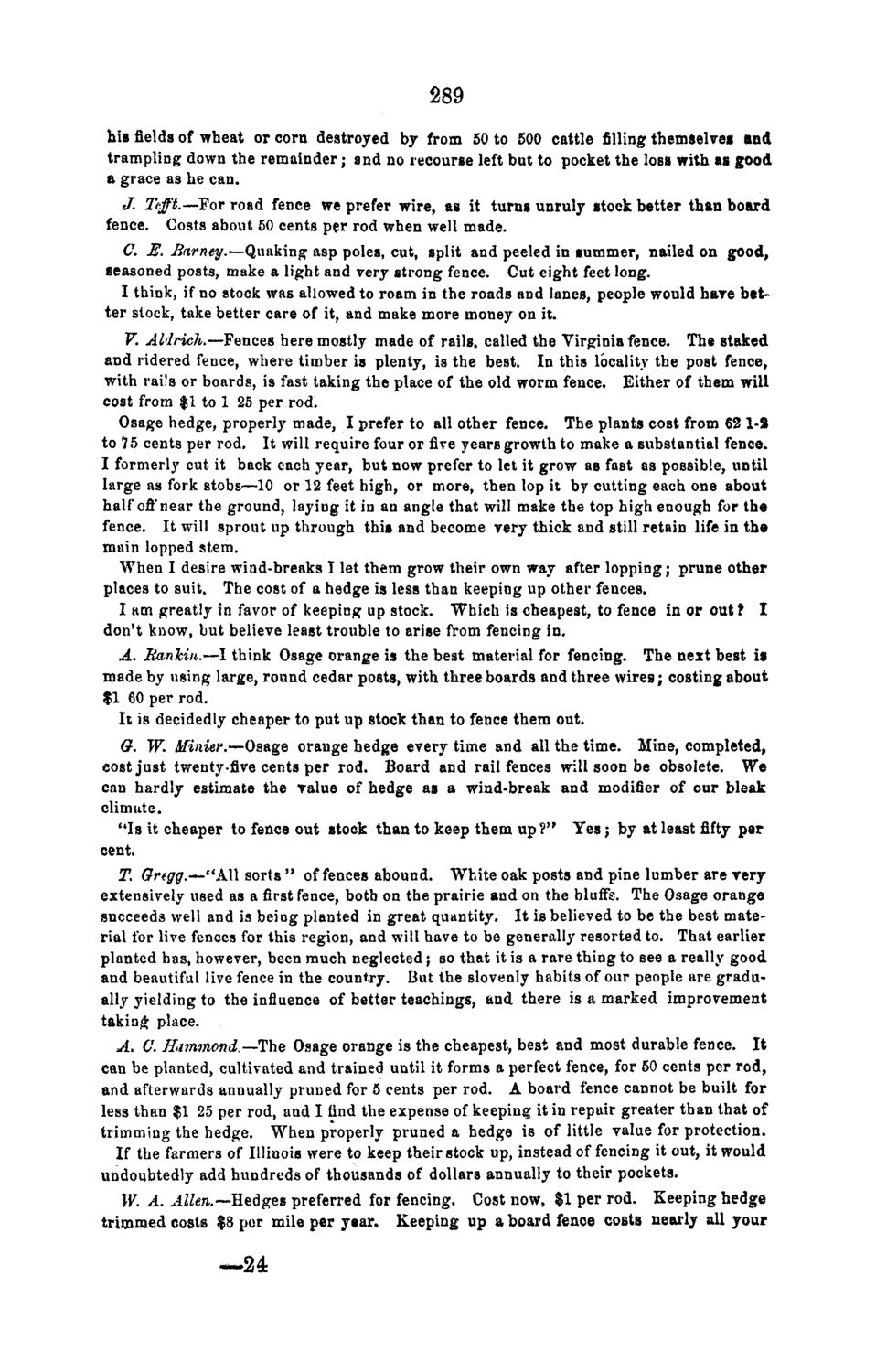| |
| |
Caption: Board of Trustees Minutes - 1868
This is a reduced-resolution page image for fast online browsing.

EXTRACTED TEXT FROM PAGE:
289 his fields of wheat or corn destroyed by from 50 to 500 cattle filling themselves and trampling down the remainder; and no recourse left but to pocket the loss with as good a grace as he can. J. Teft.—For road fence we prefer wire, as it turns unruly stock better than board fence. Costs about 50 cents per rod when well made. C. JE. Barney.—Quaking asp poles, cut, split and peeled in summer, nailed on good, seasoned posts, make a light and very strong fence. Cut eight feet long. I think, if no stock was allowed to roam in the roads and lanes, people would have better stock, take better care of it, and make more money on it. V. Aldrich.—fences here mostly made of rails, called the Virginia fence. The staked and ridered fence, where timber is plenty, is the best. In this locality the post fence, with rai?s or boards, is fast taking the place of the old worm fence. Either of them will cost from $1 to 1 25 per rod. Osage hedge, properly made, I prefer to all other fence. The plants cost from 62 1-2 to 75 cents per rod. It will require four or five years growth to make a substantial fence. I formerly cut it back each year, but now prefer to let it grow as fast as possible, until large as fork stobs—10 or 12 feet high, or more, then lop it by cutting each one about half offnear the ground, laying it in an angle that will make the top high enough for the fence. It will sprout up through this and become very thick and still retain life in the main lopped stem. When I desire wind-breaks I let them grow their own way after lopping; prune other places to suit. The cost of a hedge is less than keeping up other fences. I am greatly in favor of keeping up stock. Which is cheapest, to fence in or out? I don't know, but believe least trouble to arise from fencing in. A. Rankin.—! think Osage orange is the best material for fencing. The next best is made by using large, round cedar posts, with three boards and three wires; costing about $1 60 per rod. It is decidedly cheaper to put up stock than to fence them out. G. W. Afinier.—Osage orange hedge every time and all the time. Mine, completed, cost just twenty-five cents per rod. Board and rail fences will soon be obsolete. We can hardly estimate the value of hedge as a wind-break and modifier of our bleak climate. "Is it cheaper to fence out stock than to keep them up?" Yes; by at least fifty per cent. T. Gregg.—"All sorts " offences abound. White oak posts and pine lumber are very extensively used as a first fence, both on the prairie and on the bluffs. The Osage orange succeeds well and is being planted in great quantity. It is believed to be the best material for live fences for this region, and will have to be generally resorted to. That earlier planted has, however, been much neglected; so that it is a rare thing to see a really good and beautiful live fence in the country. But the slovenly habits of our people are gradually yielding to the influence of better teachings, and there is a marked improvement taking place. A. O. Hammond—The Osage orange is the cheapest, best and most durable fence. It can be planted, cultivated and trained until it forms a perfect fence, for 50 cents per rod, and afterwards annually pruned for 5 cents per rod. A board fence cannot be built for less than $1 25 per rod, and I find the expense of keeping it in repair greater than that of trimming the hedge. When properly pruned a hedge is of little value for protection. If the farmers of Illinois were to keep their stock up, instead of fencing it out, it would undoubtedly add hundreds of thousands of dollars annually to their pockets. W. A. Allen.—E^ges preferred for fencing. Cost now, $1 per rod. Keeping hedge trimmed costs $8 per mile per year. Keeping up a board fenoe costs nearly all your —24
| |